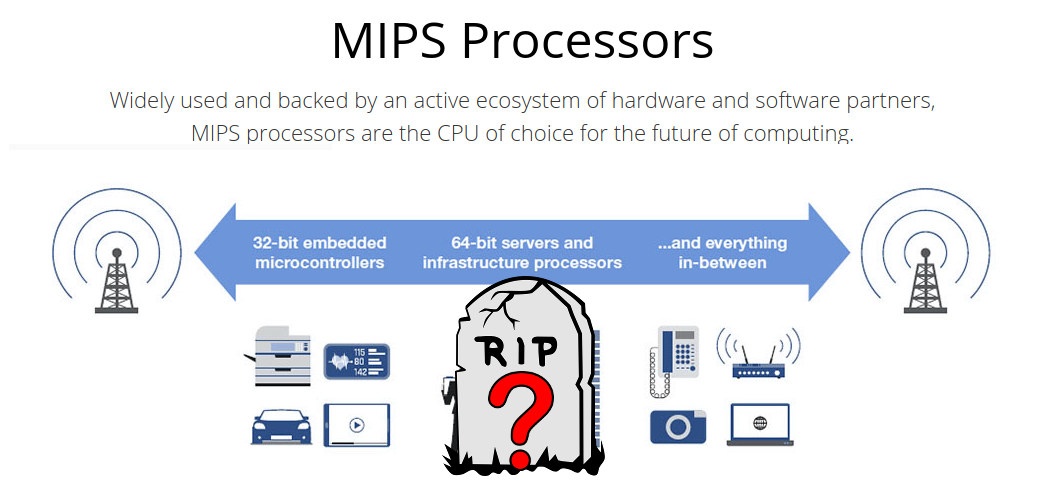When in 2018, Blu posted a guest post entitled “Baikal T1 MIPS Processor – The Last of the Mohicans?” I thought maybe it was too pessimistic with regard to the future of MIPS architecture.
At the time, MIPS belonged to Imagination Technologies, but soon the company had its own financial problems and had to sell MIPS assets to Wave Computing. The latter eventually announced the launch of MIPS Open Initiative early last year, so there was some hope as interest might pick up to compete against RISC-V and Arm again.
But in recent months, MIPS related news has not been so good. First, Wave Computing decided to end MIPS Open Initiative in November 2019, then Paul Burton and Ralf Baechle removed themselves from the Linux kernel MIPS maintainer list in February 2020, as their work with MIPS ended leaving Thomas Bogendoerfer as the only maintainer.
But this month, things turned for the worse, with CIP United filing a lawsuit against MIPS LLC on April 6, before announcing the company had obtained exclusive MIPS license rights for mainland China, Hong Kong, and Macau on April 11, 2019 (Click on News in top menu of this link).
In an article dated April 19, Semiwiki reports Wave Computing has now filed for chapter 11 bankruptcy letting all employees go. So it looks pretty bad, although there may still be some MIPS processors coming out of China in the future. but I’d expect hardware and software developments around the MIPS architecture to be seriously limited going forward, and MIPS may just eventually die off leaving the space to other IP vendors like RISC-V and Arm.
Thanks to anonymous for the tip

Jean-Luc started CNX Software in 2010 as a part-time endeavor, before quitting his job as a software engineering manager, and starting to write daily news, and reviews full time later in 2011.
Support CNX Software! Donate via cryptocurrencies, become a Patron on Patreon, or purchase goods on Amazon or Aliexpress





Weird because Broadcom also have a running MIPS License and is still producing MIPS chips… all the low end ones are mips
Bmips is EOL. Everything new from Broadcom is running arm. But if some party wants to buy old stuff I guess they will sell it to them if it makes sense business-wise.
just as the various 350 handhelds seem popular
https://www.cnx-software.com/2020/01/15/ingenic-x1830-iot-processor-features-a-32-bit-mips-core-128mb-ddr2-ram/
Ingenic joined the RISC-V foundation for a reason you know…
Yes.
Chapter 11 bankruptcy is “reorganization”. The part relevant to the premise of this article is likely “The court may also permit the debtor in possession to reject and cancel contracts.”
en.wikipedia.org/wiki/Chapter_11,_Title_11,_United_States_Code
Maybe there is a chance to free up the architecture?
I worked on some Lexra SoC:
https://www.linux-mips.org/wiki/Lexra
I guess if there are still patents on MIPS, they will be picked up by someone.
Bankrupts are the worst situation for patents because they’re sold to the highest offering party to cover for the rest of the losses. And you can bet that those acquiring them are not driven by the nicest intents :-/
I suppose most of the important patents were already sold to ARM etc al during https://www.theregister.co.uk/2012/11/06/mips_sells_itself_to_imagination_arm/, so those are at least safe from trolls but not from enforcement. The most common MIPS version to date is still MIPS32r2. That 20 years old now (MIPS 4K and 5K), and those patents should already be expired. Not sure if anyone still wants to create another MIPS32r2 core any more after RISC-V exists and MIPS Open failed already. It would be fun though to have a core that can run some or all of the now patent-free RISC ISAs: RISC-V, SPARC, Power, OpenRISC,… Read more »
I wouldn’t be surprized if someone still wanted to issue MIPS32r2 cores. They must be extremely cheap given the devices where they are found, and are pretty much energy efficient. Some would possibly call them micro-controllers by now, but they definitely are found in real CPUs like a number of the AR93xx chips. I’d compare these cores to ARM’s 926 in terms of capabilities and performance. Sure it’s dated but it’s robust.
Meanwhile in China
https://www.phoronix.com/scan.php?page=news_item&px=Loongson-More-Patches-Ahead-5.8
The bankruptcy proceedings are over, and Wave Computing came out of Chapter 11, and renamed itself MIPS. So MIPS is back, with the company still supporting existing MIPS architectures, and working on “an 8th generation” open-source RISC-V processor standard going forward.
https://www.eetimes.com/wave-goodbye-hello-mips-as-chapter-11-resolved/